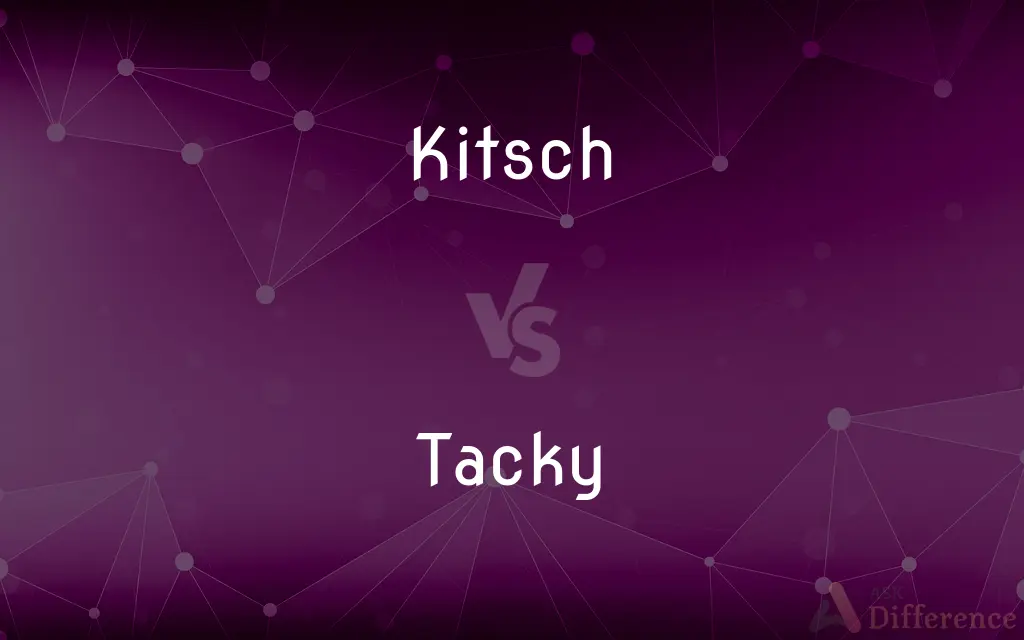Kitsch vs. Tacky — What's the Difference?
By Fiza Rafique & Maham Liaqat — Updated on April 16, 2024
Kitsch refers to art, objects, or design considered to be in poor taste because of excessive garishness or sentimentality, but often appreciated in knowing way. Tacky describes something that is cheap, shoddy, or in poor taste without ironic appreciation.

Difference Between Kitsch and Tacky
Table of Contents
ADVERTISEMENT
Key Differences
Kitsch often includes art or decorative objects that are overly sentimental, gaudy, or clichéd, intentionally embracing a sort of exaggerated tastelessness. In contrast, tacky refers to items or styles that appear thoughtlessly gaudy or cheap, typically without the self-awareness or ironic intent that kitsch might embody.
Art that is considered kitsch is usually admired for its ironic value or as a deliberate celebration of bad taste. Whereas, tacky items are often criticized for lacking stylistic or aesthetic value, seen simply as poor choices without artistic intent.
Kitsch can be a conscious choice by artists or collectors to invoke nostalgia or make a statement against mainstream notions of good taste. On the other hand, tacky often results from a lack of awareness about style and aesthetics, leading to choices that are seen as inelegant or in poor taste.
In terms of popularity, kitsch has a cultural niche, often celebrated in various subcultures and art movements as a form of anti-art. Meanwhile, tacky is generally used pejoratively to describe elements that fail to meet accepted standards of style and quality.
Kitsch is sometimes used in a more positive context, appreciated among certain groups for its campy and amusing qualities. Tacky, however, is rarely seen in a positive light, frequently associated with a lack of sophistication and excess.
ADVERTISEMENT
Comparison Chart
Intent
Often ironic or self-aware
Lacks irony or self-awareness
Cultural Perception
Sometimes positive, campy
Generally negative
Style
Deliberately exaggerated
Inadvertently excessive
Purpose
To critique or celebrate bad taste
Lack of style awareness
Common Contexts
Art, fashion, home decor
Fashion, decor, behavior
Compare with Definitions
Kitsch
A celebration of tackiness within popular culture, often as an art movement.
The museum exhibit on kitsch showcased an ironic appreciation for 1970s decor.
Tacky
Describing something sticky; not completely dry or smooth to touch.
The varnish on the chair was still tacky, leaving fingerprints.
Kitsch
Objects or themes that are excessively ostentatious to the point of being comical.
The kitsch painting featured a crying clown in an overly dramatic, sparkly frame.
Tacky
Considered to be in poor taste, lacking subtlety or sophistication.
Wearing a bright, flashy suit to a solemn occasion is just tacky.
Kitsch
A style that is appealing or amusing because of its bad taste or irony.
She decorated her cafe in kitsch 1950s decor, complete with vinyl booths and neon signs.
Tacky
Ill-considered or showing bad judgment in style or etiquette.
It's tacky to ask about someone's salary on a first date.
Kitsch
Anything that is considered overly sentimental or gaudy, often ironically.
His collection of kitsch Christmas sweaters was hit at the office party.
Tacky
Showing poor taste and quality, often excessively gaudy.
The tacky wallpaper made the room look dated and cluttered.
Kitsch
Art or objects that deliberately emphasize garishness or sentimental motifs.
The bright pink flamingo lawn ornaments are perfect examples of kitsch.
Tacky
Cheap or shoddy in appearance or quality, lacking class.
Those plastic tablecloths look tacky at a formal wedding.
Kitsch
Kitsch ( KITCH; loanword from German) is a term applied to art and design that is perceived as naïve imitation, gratuitous, or of banal taste.According to early critical theory, kitsch provides immediate gratification based on contrived sentiment. Behind a culture industry, kitsch works to pacify difference, or social complexity, and engender a psychological interdependence with homogenous consumerism.The avant-garde opposed kitsch as melodramatic and superficial affiliation with the human condition and its natural standards of beauty.
Tacky
Slightly adhesive or gummy to the touch; sticky.
Kitsch
Pieces of art or other objects that appeal to popular or uncultivated taste, as in being garish or overly sentimental.
Tacky
Lacking style or good taste; tawdry
Tacky clothes.
Kitsch
Art, decorative objects, and other forms of representation of questionable artistic or aesthetic value; a representation that is excessively sentimental, overdone, or vulgar.
Tacky
Distasteful or offensive; tasteless
A tacky remark.
Kitsch
Of art and decor: of questionable aesthetic value; excessively sentimental, overdone or vulgar.
Tacky
Flimsy, rundown, or in poor repair
"a tacky room he could tear apart with his bare hands" (John Edgar Wideman).
Kitsch
Art in pretentious bad taste
Tacky
Of a substance, slightly sticky.
This paint isn't dry yet; it's still a bit tacky.
Kitsch
Of a display that is tawdry or vulgar
Tacky
(colloquial) Of low quality.
That market stall sells all sorts of tacky ornaments.
Tacky
(colloquial) In poor taste.
That was a tacky thing to say.
Tacky
Gaudy or flashy.
Tacky
Shabby, dowdy in one's appearance or dress.
Tacky
Sticky; adhesive; raw; - said of paint, varnish, etc., when not well dried.
Tacky
Dowdy, shabby, or neglected in appearance; unkempt.
Tacky
In poor taste; appearing cheap; gaudy; unstylish. Broadly used to describe objects whose style is disapproved of by the speaker.
Tacky
Tactless; in poor taste; - used to describe behavior.
Tacky
An ill-conditioned, ill-fed, or neglected horse; also, a person in a like condition.
Tacky
(of a glutinous liquid such as paint) not completely dried and slightly sticky to the touch;
Tacky varnish
Tacky
Tastelessly showy;
A flash car
A flashy ring
Garish colors
A gaudy costume
Loud sport shirts
A meretricious yet stylish book
Tawdry ornaments
Common Curiosities
Are kitsch items considered valuable?
Kitsch items can be valuable, especially in niche markets or among collectors who value the ironic or cultural commentary aspects of kitsch.
How is tacky generally perceived in fashion?
In fashion, tacky is perceived negatively, indicating a lack of style, sophistication, or subtlety in the choice of garments or accessories.
Can tacky ever become kitsch?
Yes, what is initially considered tacky can become kitsch if it is later embraced with irony and becomes part of a cultural commentary or artistic movement.
Is kitsch intentional?
Kitsch is often intentional, created or embraced with a conscious acknowledgment of its clash with established tastes or its exaggerated sentimentality.
How do trends affect the perception of tacky and kitsch?
Trends can shift something from being seen as tacky to being fashionable or kitsch as societal tastes and values change over time.
What impact does irony have on kitsch?
Irony is central to kitsch; it transforms what might be viewed as mere bad taste into a stylistic statement or critique, making it culturally significant.
What is a common use of kitsch in interior design?
In interior design, kitsch is often used to create a playful, nostalgic, or ironic atmosphere, utilizing objects and styles that are overtly sentimental or dated.
What role does cultural context play in defining something as kitsch or tacky?
Cultural context greatly influences whether something is seen as kitsch or tacky, with variations in how different societies interpret and value taste and aesthetics.
How does one differentiate between kitsch and camp?
Kitsch and camp overlap but are not identical; camp involves a deliberate, sophisticated performance of exaggerated style, while kitsch is more about the appreciation of mass-produced, sentimental, or outdated items.
What makes an item or style kitsch rather than just tacky?
An item or style becomes kitsch when it adopts elements of bad taste with a sense of irony or artistic intent, rather than just poor quality or lack of sophistication.
Is there a place for tacky items in modern decor?
While generally considered in poor taste, tacky items can find a place in modern decor when used with a sense of humor or irony, particularly in eclectic or thematic settings.
How do people typically respond to tacky gifts?
Responses to tacky gifts can vary from amusement and appreciation for the humor to discomfort or disdain, depending on the context and the relationship between giver and receiver.
How does one curate a kitsch collection?
Curating a kitsch collection involves selecting items that not only embody the essence of kitsch but also resonate personally or make a statement about culture, art, or aesthetics.
Can kitsch be a form of protest?
Yes, kitsch can be a form of protest against dominant cultural norms and tastes, using its exaggerated style to critique or mock mainstream aesthetics.
Can kitsch be found in high art?
Kitsch elements can indeed be found in high art, particularly when artists incorporate or transform kitsch into something that challenges traditional definitions of art.
Share Your Discovery

Previous Comparison
Keypad vs. Joystick
Next Comparison
Byzantine vs. KafkaesqueAuthor Spotlight
Written by
Fiza RafiqueFiza Rafique is a skilled content writer at AskDifference.com, where she meticulously refines and enhances written pieces. Drawing from her vast editorial expertise, Fiza ensures clarity, accuracy, and precision in every article. Passionate about language, she continually seeks to elevate the quality of content for readers worldwide.
Co-written by
Maham Liaqat













































